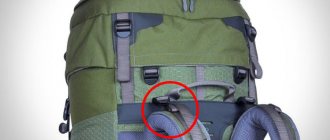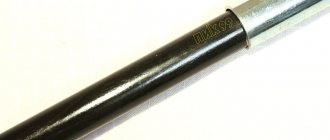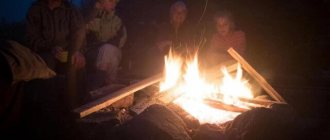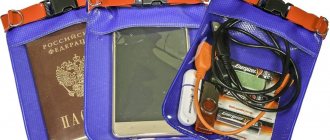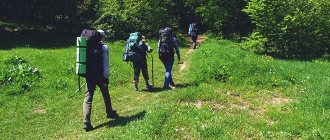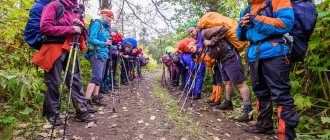UPD 03/03/2018, 09/08/2018, 06/24/2019, 02/20/2020, 10/18/2020
Descriptions of things, advice on purchasing clothes and equipment for people who decide to take up tourism. And it doesn’t matter what kind: on foot, by boat, etc. The list of equipment and clothing below is universal and is suitable for any trip in the summer and off-season where special equipment is not needed. Mountain, winter, water and other hikes have their own characteristics, but the things listed below are still needed.
This article is specifically about personal equipment - equipment that every tourist should have. Read about group equipment (kettles, burners, navigation, tents, radio stations and satellite communications, etc.) in separate articles.
If you don’t need buying tips, but a list of things for a hike , then you can find a ready-made one or make your own list.
BACKPACK
Volume up to 90 liters for a guy, 75 for a girl. There's definitely no need for more.
If you are going to go only on PVD (weekend hikes), then 70 will be enough for a guy (even 50 will be just right for the summer). The main criterion for a backpack is a good back and waist belt. Feel free to ask the seller to load the backpack and try it on loaded. In a normal store they will always understand. In a well-fitted backpack, most of the weight should rest on the belt, and the straps should only serve to prevent the backpack from leaning back.
Pay attention to how the flap (the flap is the top of the backpack - its “lid”) is attached to the back of the backpack.
The flap is sewn to the back. It is not removable; you cannot stuff large items under the flap when the backpack is full to the brim. The valve is attached to the back using slings. It can be removed and used as a small backpack. Also, the slings can be released, the valve will “move” up and the backpack can be filled beyond the norm
The backpack strap is the basis of everything. If it is not placed correctly or is not tightened, the weight of the backpack will fall on your shoulders and it will be difficult for you. Pay attention to how the belt is tightened.
The sling comes out of the fastening of the waist belt. You have to pull from the center to the side. This is not convenient and a fragile girl or child will not be able to tighten the belt tightly enough. The lines pass through the fast and go to the double slots. This creates a block that is easier to pull through. The movement of the hand goes from the side to the center. This belt is easy for anyone to tighten.
Zippered pockets improve usability but add weight. Military versions made of thick fabric with numerous slings sewn on are also unnecessarily heavy. The weight of the backpack is not the most important factor (its back is more important), but as a guide, aim for a backpack weighing about 2.5 kg , if less is good.
I don’t use the inner partition of the backpack; I usually cut it off to save weight. Remember that if you use this partition, you will be able to fit less stuff into your backpack than if the partition is unzipped.
a rain cape is included with the backpack Designed to keep the backpack and its contents dry. It is often thin - it breaks, small - the rug does not fit under it or is blown away by the wind, flies off, caught on twigs, etc. Therefore, I advise you not to get hung up on this accessory and store all wet items in waterproof bags (sleeping bag, clothes, electronics). So you can even bathe your backpack in the river - everything will remain dry. I usually choose a green cape and use it to hide my backpack in the bushes when I want to go for a walk without it. In addition to the actual protection from rain, the cape protects the backpack from dirt or passers-by/subway passengers from an already dirty backpack
